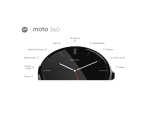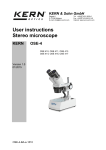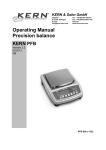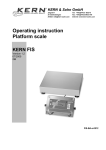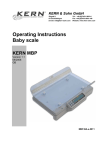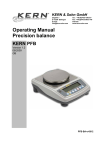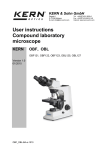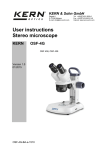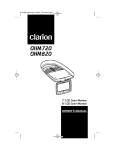Download User instructions Compound laboratory microscope KERN OBE 111
Transcript
KERN & Sohn GmbH Ziegelei 1 D-72336 Balingen E-mail: [email protected] Tel: +49-[0]7433- 9933-0 Fax: +49-[0]7433-9933-149 Internet: www.kern-sohn.com User instructions Compound laboratory microscope KERN OBE 111, OBE 112, OBE 113 Version 1.0 01/2015 OBE-1-BA-e-1510 GB KERN OBE-1 Version 1.0 01/2015 User instructions Compound microscopes Table of contents 1 Before use .................................................................................... 3 1.1 1.2 1.3 1.4 General notes ............................................................................................................................ 3 Notes on the electrical system ................................................................................................ 3 Storage ...................................................................................................................................... 4 Maintenance and cleaning ....................................................................................................... 4 2 Nomenclature ............................................................................... 5 3 Technical data / model outfit ....................................................... 7 4 Assembly ...................................................................................... 8 4.1 4.2 4.3 4.4 Lenses ....................................................................................................................................... 8 Condenser ................................................................................................................................. 8 Head ........................................................................................................................................... 8 Eyepieces .................................................................................................................................. 8 5 Operation ...................................................................................... 9 5.1 5.2 5.3 5.4 5.5 Getting started .......................................................................................................................... 9 Adjust the gap between the eyes (only for OBE 112, OBE 113) .......................................... 9 Adjusting the magnification .................................................................................................... 9 Adjust the brightness............................................................................................................. 10 Dioptre compensation and focussing .................................................................................. 10 6 Storage ....................................................................................... 11 7 Maintenance ............................................................................... 11 7.1 7.2 Changing the bulb .................................................................................................................. 11 Changing the fuse .................................................................................................................. 11 8 Trouble shooting ........................................................................ 12 9 Service ........................................................................................ 14 10 Disposal ...................................................................................... 14 11 Further information .................................................................... 14 OBE-1-BA-e-1510 2 1 Before use 1.1 General notes You must open the packaging carefully, to make sure that none of the accessories in the packaging fall on the floor and get broken. In general, microscopes should always be handled carefully because they are sensitive precision instruments. When using or transporting the microscope it is particularly important to avoid abrupt movements, as this may damage the optical components. You should also avoid getting dirt or finger prints on the lens surface, because in most cases this will reduce image clarity. To maintain the performance of the microscope, it must never be disassembled. So components such as lenses and other optical elements should be left as they were before use. Also the electrical parts in the base of the device must not be tampered with, as in this area there is an additional risk of triggering an electric shock. 1.2 Notes on the electrical system Before connecting to a mains power supply, you must make sure that you are using the correct input voltage. The information to select the correct mains cable is located on each device, on the rear of the product directly above the connection socket. You must comply with this information. If you do not comply with these specifications, then fires or other damage to the device could occur. The main switch must also be switched off before the mains cable is connected. In this way you will avoid triggering an electric shock. If you are using an extension cable, then the mains cable you use must be earthed. If the original fuse should blow, it must only be replaced by an appropriate fuse. Suitable replacement fuses are included with the delivery. When carrying out any procedures whereby you come into contact with the electrical system of the device, such as, for example, changing the bulb or fuse, only carry out these procedures when the power is disconnected. 3 OBE-1-BA-e-1510 1.3 Storage You should ensure that the device is not exposed to direct sunlight, temperatures which are too high or too low, vibrations, dust or a high level of humidity. The ideal temperature range is between 0 and 40°C and a relative humidity of 85% should not be exceeded. The device should always be located on a rigid, smooth, horizontal surface. When the microscope is not being used, you should fit the lens cap and cover the microscope with the enclosed dust protective cover. If the eyepieces are being stored separately, the protective caps must be fitted to the lens barrels. In most cases, if dust and dirt gets inside the optical unit of a microscope this can cause irreversible errors or damage. The best way to store accessories which consist of optical elements, such as, for example, eyepieces and lenses, is in a dry box with desiccant. 1.4 Maintenance and cleaning In any event, the device must be kept clean and dusted regularly. If any moisture should be occur, before you wipe down the device you must ensure that the mains power is switched off. When glass components become dirty, the best way to clean them is to wipe them gently with a lint-free cloth. To wipe oil stains or finger prints off the lens surface, moisten the special lint free cleaning cloth with a mixture of ether and alcohol (70 / 30 ratio) and use this to clean the lens. You must be careful when handling ether and alcohol, as these are highly flammable substances. You must therefore keep it away from naked flames and electrical devices which can be switched on and off, and only use it in well-ventilated rooms. However organic solutions of this type should not be used to clean other components of the device. This could lead to damage to the paint finish. To do this, it is sufficient to use a neutral cleaning product. You could also use the following cleaning products to clean the optical components: Special cleaner for optical lenses Special optical cleaning cloths Bellows Brush When handled correctly and checked regularly, the microscope should give many years of efficient service. Should repairs still be necessary, please contact your KERN dealer or our Technical Department. OBE-1-BA-e-1510 4 2 Nomenclature Eyepiece Lens barrel connectors Head Lens revolving unit Lens Object holder Specimen stage Condenser Aperture adjustment Condenser Field lens Adjusting screw Head Coarse adjustment knob Fine adjustment knob Control dial X – Y axis Specimen stage Main On/Off switch + dimmer 5 OBE-1-BA-e-1510 Rear view Example OBE 111 (monocular) Coarse adjustment knob Fine adjustment knob Adjusting ring torque Mains connection Fuse Condenser Focus dial OBE-1-BA-e-1510 6 3 Technical data / model outfit 7 OBE-1-BA-e-1510 4 Assembly 4.1 Lenses The lenses are screwed into the lens revolving unit in such a way that when you turn the revolving unit, the next lens for stronger magnification moves into position. Please make sure that you do not touch the lenses with your fingers and that no dust enters the apertures. For lenses which are marked “OIL”, you must use an immersion oil with the lowest level of inherent fluorescence. 4.2 Condenser The condenser is already permanently fitted in the device. The height can be adjusted using the focus dial. 4.3 Head The head is already fitted on the device. After loosening the adjusting screw, the head can be rotated by 180 degrees, for example. Then the gently retighten the adjusting screw. Please make sure that you do not touch the lenses with your fingers and that no dust enters the apertures. 4.4 Eyepieces For each eye, use an eyepiece with the same magnification. (Only applies to the OBE 111 microscope, only one eyepiece available on this). Remove the plastic protective caps and insert both eyepieces. Please make sure that you do not touch the lenses with your fingers and that no dust enters the apertures. OBE-1-BA-e-1510 8 5 Operation 5.1 Getting started Plug the mains plug into the socket and plug the cold device plug into the device. Switch on the main switch and use the dimmer (switch and dimmer are combined in one rotary knob) to adjust the brightness of the bulb (at the beginning, select a low level of brightnesss. 5.2 Adjust the gap between the eyes (only for OBE 112, OBE 113) Different users have different gaps between the eyes. So each time a different person uses the microscope, the gap between the two eyepieces must be readjusted. While you are looking through the eyepieces, use one hand to hold the right or left lens barrel firmly. By pulling them apart or pushing them together, you can either increase or reduce the gap between the eyes. As soon as the left and right visual fields fully overlap each other (only one circular image is visible), this is the correct gap between the eyes. 5.3 Adjusting the magnification Select the lens with the lowest magnification and make sure that the lens revolving unit is properly clicked into place. Place the test object on the specimen stage and fix it with the object holder, if necessary. Use the control dial for the X-Y axis specimen stage to position the sample in the correct place (central under the middle of the lens). Carefully raise the specimen stage using the coarse adjustment knob, until the slide is almost touching the lens (observe from the side). The lens must not touch the object holder (risk of glass breakage). Look through the eyepieces (just one eyepiece with the OBE 111 device) and use the coarse adjustment knob to lower it slowly until the object is visible. If necessary, adjust the brightness by adjusting the bulb (potentiometer). Avoid overexposure. Now use the fine adjustment knob to adjust the focus. For slides with low contrast or a small number of objects, for example individual cells, we recommend that you use a high-contrast standard slide to help you to make the adjustment to find the correct level. Once you have found a point which must be observed more closely, this must be adjusted to be in the middle of the visual field (x/y adjustment of the stage). To be able to view the required section of the object, this section must be positioned centrally under the lens. 9 OBE-1-BA-e-1510 5.4 Adjust the brightness Adjust condenser aperture Adjust the height of the condenser until the image from the field diaphragm appears clearly in the visual field. For some microscopes there is a risk that you will lift the condenser up so high that it collides with the object holder. Care is needed when doing this. For each slide, use the aperture diaphragm of the condenser to find the very best compromise between contrast and brightness for the microscopic image. The scale on the condenser is to be regarded as a recommendation for each lens. It is possible to alter the brightness of the bulb using the dimmer. The brightness is always controlled by the bulb brightness. It is possible to re-adjust the focus and x-y axis. Observe the object. 5.5 Dioptre compensation and focussing For models with dioptre setting: Keep the eye on the fixed, non-adjustable lens barrel open and close the eye which is on the adjustable lens barrel. Then adjust the focus for the open eye using the fine adjustment knob. Then open the other eye and shut the eye which had been open. Then adjust the focus for the second eye on the dioptre setting. When doing this, do not touch the fine adjustment knob. If necessary, alter the brake action for the control knobs using the locking ring. The rotary knobs on the lefthand side are connected to the rotary knobs on the righthand side. Please only rotate on one side at a time, do not rotate right and left at the same time in opposite directions, otherwise this will damage the drive. Turning the lens revolving unit will bring the lens with the next magnification level into position. Make sure that the lens clicks properly into place. When rotating the lenses, check from the side to make sure that the glass holder does not get damaged by the lens. Under normal conditions you should be able to select the next lens immediately and the focus should be roughly at the same level. Make additional adjustments with the fine adjustment knob. If when you rotate the lens it hits the object holder, you must first lower the specimen stage and re-adjust it. For lenses which work with oil immersion (these are marked with the word “oil”), first put the oil drops on the slide, bring the lens into position and move it closer to the object holder. The link between the object holder and lens is the oil. After use or before changing the slide, remove the oil using a dust-free cloth. OBE-1-BA-e-1510 10 6 Storage It is important that the microscope is covered with the enclosed protective cover after each use. In the long term, this is the only way to protect it from getting dirty. Ideally the microscope will be used in an air-conditioned room. If the microscope is not used for several days, then we would recommend that it is stored in a cupboard with its protective cover. Dust and moisture are the greatest enemies of the microscope. 7 Maintenance These microscopes are generally maintenance-free. Service work should be limited to the replacement of bulbs, light sources and electrical fuses. Should a defect occur, please contact your dealer or KERN Service. 7.1 Changing the bulb The devices in the OBE range all have LED lighting. In general, LEDs are very longlasting. However, if you still suspect that a bulb is broken, then please contact our Service Department. 7.2 Changing the fuse Switch the device off and unplug it. Unscrew the fuse housing on the right next to the mains cable socket, remove the old fuse and fit a new fuse. Screw the fuse housing back in. 11 OBE-1-BA-e-1510 8 Trouble shooting Problem Possible causes The bulb does not light The mains plug is not correctly plugged in There is no power at the socket Defective bulb / LED Defective fuse The bulb blows immediately The visual field is dark You cannot adjust the brightness The specified bulb or fuse has not been used. The aperture diaphragm is not opened wide enough . The brightness control has been set incorrectly The condenser is too low. The visual field is dark or is not correctly illuminated. The lens has not been correctly adjusted The object revolving unit is not correctly fitted. The condenser is not correctly fitted A lens is being used which doesn’t match the lighting area of the condenser. The bulb/LED is not fitted correctly. The gap between the eyes is not The visual field of one eye does not correctly match that of the other eye. adjusted. Different eyepieces are used for the right and left side. (Only OBE112 and OBE113) The eyes are not used to using a microscope. Dioptre setting has not been carried out correctly. OBE-1-BA-e-1510 12 Blurred details The aperture diaphragm is not opened wide enough . Bad image The condenser is too low. Bad contrast Vignetted visual field The lens does not belong to this microscope. The front lens of the lens unit is dirty. An immersion object has been used without immersion oil The immersion oil contains air bubbles The recommended immersion oil has not been used. Dirt / dust on the lens Dirt / dust on the front lens of the condenser. Dirt or dust in the visual field Dirt / dust on the eyepieces Dirt / dust on the front lens of the condenser. Dirt / dust on the object. One side of the image is blurred The image flickers The coarse adjustment knob is difficult to turn The stage moves down on its own. The stage has not been assembled correctly. The lens is not positioned correctly on the beam path. The lens revolving unit is not correctly fitted. The upper side of the object is facing down. The lens revolving unit is not correctly fitted The lens is not positioned correctly on the beam path. The torque adjusting ring is overtightened. The angle table is blocked by a solid body. The torque adjusting ring is not tight enough. The fine adjustment knob moves on its own When you move the table, the image The stage was not correctly fitted becomes blurred 13 OBE-1-BA-e-1510 9 Service If, after studying the user manual, you still have questions about commissioning or using the microscope, or if unforeseen problems should arise, please get in touch with your dealer. The device may only be opened by trained service engineers who have been authorised by KERN. 10 Disposal The packaging is made of environmentally-friendly materials, which you can dispose of at your local recycling centre. Disposal of the storage box and device must be carried out by the operator in accordance with all national or regional laws in force in the location of use. 11 Further information The illustrations may differ slightly from the product. The descriptions and illustrations in this user manual are subject to change without notice. Further developments on the device may lead to these changes. All language versions contain a non-binding The original German document is the binding version. OBE-1-BA-e-1510 translation. 14
















